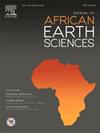Seismotectonic map of the Sinai Triple Junction
IF 2.2
4区 地球科学
Q2 GEOSCIENCES, MULTIDISCIPLINARY
引用次数: 0
Abstract
The geodynamic evolution of the Sinai Triple Junction, a highly deformed and seismically active area, is controlled by the Red Sea rift, Gulf of Suez and Aqaba-Dead Sea conjunctions. However, the driving forces for the focusing deformation at crustal depths beneath this area are still ambiguous. Here, we provide an updated seismotectonic map of the area relying on updated seismological and geodetic datasets. A homogenized earthquake catalog has been compiled from well-located earthquakes (> Mw 2.0) by the Egyptian Seismic Network and International Seismological Center in the period between 1990 and 2020. We calculated the average b-value along three seismogenic zones including Gulf of Aqaba, northern Red Sea and Gulf of Suez that amount to 1.1, 0.99 and 0.97, respectively. Additionally, we complied and updated a comprehensive P-wave-based database for the fault plane solutions in the area for events with Mw > 3.5 till 2023. Furthermore, a unified velocity field for the region as well as slip-rate and locking-depth at the active fault segments were estimated from a consistent geodetic dataset from peer-reviewed GPS velocities between 1999 and 2018. Results indicate a dominant NNE left-lateral strike-slip fault with normal component along the Gulf of Aqaba. Pure NW-SE to WNW-ESE dip-slip normal faulting, associated with a strike-slip component in some cases, is dominating the northern and central parts of the Gulf of Suez, whereas pure normal dip-slip movement with an NNE–SSW extension in a horizontal direction is observed in the southern part of the gulf. The estimated slip-rate and locking-depths at the Aqaba fault segments falls between 4.8 and 4.9 mm/yr and 8–12 km, respectively.
西奈三交界处地震构造图
西奈三交界处是一个高度变形和地震活跃的地区,其地球动力演化受红海裂谷、苏伊士湾和亚喀巴-死海交汇处的控制。然而,该地区地壳深处集中变形的驱动力仍不明确。在此,我们根据最新的地震学和大地测量数据集,提供了该地区最新的地震构造图。埃及地震网络和国际地震中心根据 1990 年至 2020 年期间位置良好的地震(> Mw 2.0)编制了一份同质化地震目录。我们计算了三个地震带(包括亚喀巴湾、红海北部和苏伊士湾)的平均 b 值,分别为 1.1、0.99 和 0.97。此外,我们还为该地区 2023 年前发生的 Mw > 3.5 事件的断层面解决方案编制并更新了基于 P 波的综合数据库。此外,我们还根据 1999 年至 2018 年间经同行评审的 GPS 速度数据集,对该地区的统一速度场以及活动断层段的滑移率和锁定深度进行了估算。结果表明,阿卡巴海湾沿线有一个主要的 NNE 左侧走向滑动断层,并带有正常成分。苏伊士湾北部和中部主要是纯粹的 NW-SE 至 WNW-ESE 向倾滑正断层,在某些情况下还伴有走向滑动成分,而在苏伊士湾南部则观察到 NNE-SSW 向水平方向延伸的纯正向倾滑运动。据估计,亚喀巴断层段的滑移率和锁定深度分别为 4.8 至 4.9 毫米/年和 8 至 12 千米。
本文章由计算机程序翻译,如有差异,请以英文原文为准。
求助全文
约1分钟内获得全文
求助全文
来源期刊

Journal of African Earth Sciences
地学-地球科学综合
CiteScore
4.70
自引率
4.30%
发文量
240
审稿时长
12 months
期刊介绍:
The Journal of African Earth Sciences sees itself as the prime geological journal for all aspects of the Earth Sciences about the African plate. Papers dealing with peripheral areas are welcome if they demonstrate a tight link with Africa.
The Journal publishes high quality, peer-reviewed scientific papers. It is devoted primarily to research papers but short communications relating to new developments of broad interest, reviews and book reviews will also be considered. Papers must have international appeal and should present work of more regional than local significance and dealing with well identified and justified scientific questions. Specialised technical papers, analytical or exploration reports must be avoided. Papers on applied geology should preferably be linked to such core disciplines and must be addressed to a more general geoscientific audience.
 求助内容:
求助内容: 应助结果提醒方式:
应助结果提醒方式:


